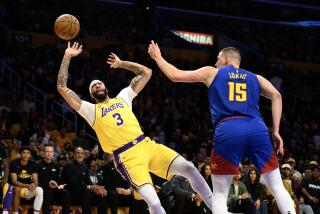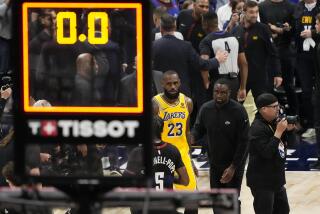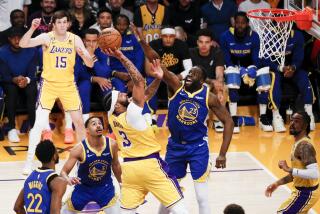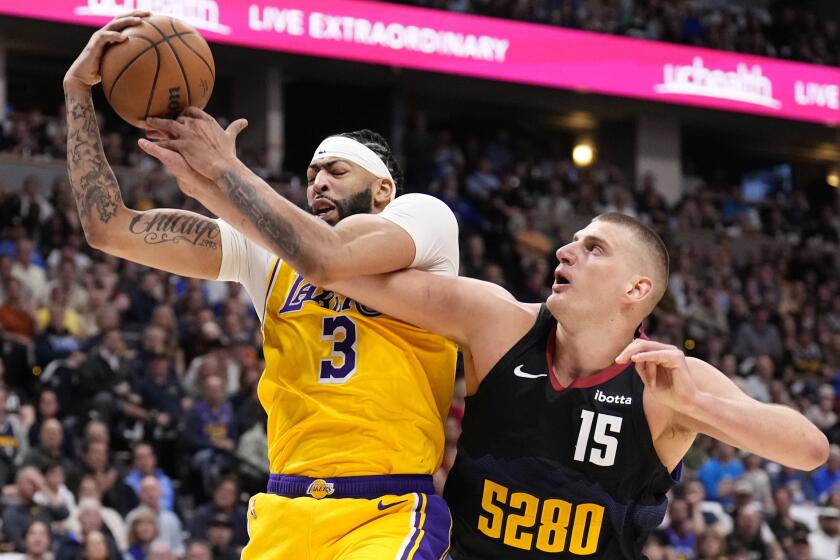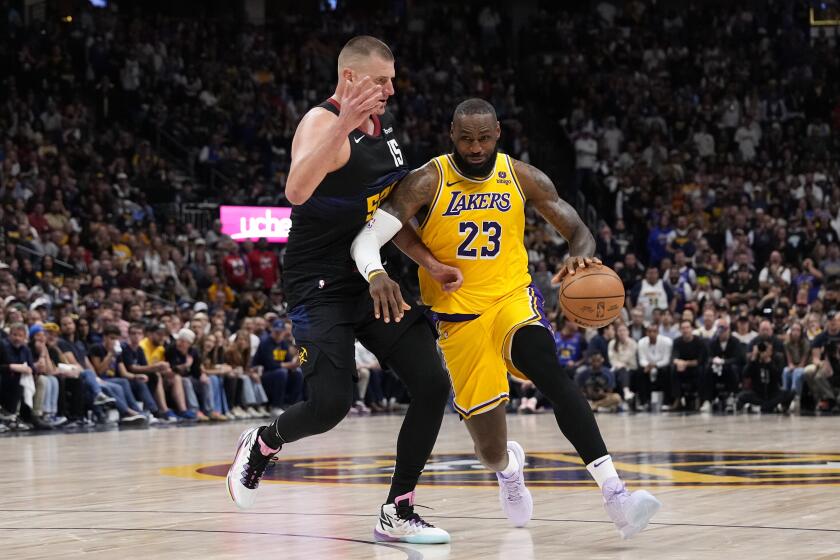With a Great Divide, Laker Season Hasn’t Really Come Together
It is late February of a wild, fractured season, a season as strange as any in memory. The Lakers have just defeated the Suns, 104-92, in Phoenix, the fourth victory in a row for a team struggling to live up to immense expectations.
Two of basketball’s reigning stars, Kobe Bryant and Shaquille O’Neal, are engulfed by writers and camera crews in separate groups that push at the gray locker room walls. One after the other, the two athletes finish answering questions and slip out into the dim cinderblock tunnel that leads to the team bus.
Fans have come down from the stands, pressing against metal barricades. Their shouts swell through the tunnel.
“Kobe! Kobe!”
“Shaq! Hey, Shaq!”
Bryant stops for a moment to sign autographs. O’Neal moves past and pauses a little ahead of Bryant, taking scorecards and pieces of paper in his huge hands, scrawling his name. Bryant drifts ahead of O’Neal. He poses for pictures with VIP guests in the tunnel. O’Neal goes ahead again, his gaze aloft, ambling toward an open area where he spends a few moments with a young boy in a wheelchair.
Not once do O’Neal and Bryant look at each other. Not once do they exchange a quip or casual remark. It is as if each journeys alone, treading through parallel realities. It’s the same at arenas in Atlanta and Minneapolis, in hotel lobbies in Oakland and Boston, after wins and losses alike. Teammates and Laker employees, who see the two stars in places where the public and the media do not, insist that they do find occasions to talk, that they often joke and laugh like old buddies, but after eight years they share no real friendship.
Neither takes time from the routines of the road to sit down together over dinner, for example. At Staples Center, the Lakers’ home court, Bryant’s cubicle is in a corner opposite O’Neal’s; they could be prizefighters staring across the ring, except there is no eye contact at all, never even a glance. Nothing of the casual repartee or tacit acknowledgments of men at peace with each other.
Their war of wills -- a standoff that threatens to shatter one of the most talented basketball teams ever assembled -- is most evident in the spaces of what is not said, the cold silences that make it clear something is amiss. No one can fix it. Few dare try. The fissure runs too deep between these gifted, headstrong men, who suggest the best and worst of American professional sports.
Under the gloss and smokescreens lie fearsome competitors, titans of marketing and popular culture, who crave more than the glory of winning championships -- who seek the acclaim of individual greatness, a glory that outshines all of their riches and awards and titles. One thing Bryant and O’Neal have in common -- one of the few things -- is an acute awareness of the legacies they are shaping; and underscoring their rival campaigns, like a line drawn in the sand, is a persistent and prickly issue:
Is this Shaq’s team?
Or is it Kobe’s team?
In the hard-smack society of the National Basketball Assn., the elite define their kingdoms in that loose possessive vernacular. They talk of “my team” and it is understood that they claim a status above their teammates, a leadership role ceded to them by stardom. The implications extend beyond personal pride. Along with it comes the power to influence the entire character of a team, even in some instances who coaches it, which players are traded, what offensive and defensive schemes are followed and who gets to take the shots in the crucial late minutes of a game.
NBA coaches wield a fragile authority, because top players are usually far better paid and more highly valued by a franchise. Most teams, therefore, need a single strong leader on the floor and in the locker room to command the sort of unity that brings success. The Lakers have three official captains -- O’Neal, Bryant and veteran forward Rick Fox -- but for years there has been no clear answer as to who is really the man. No one has emerged the way Magic Johnson did on the championship teams of the 1980s.
Nothing has given O’Neal -- the most powerful force in the game -- a clear enough edge to consign Bryant, a basketball prodigy, to No. 2.
The uncertainty is one culprit, along with injuries and off-the-court distractions, in a rocky Laker season that began in October with a flurry of wins but has since disappointed fans who expected basketball’s most glamorous team to become a juggernaut.
The Lakers now trail the San Antonio Spurs, two games to none, in the second round of the NBA playoffs. Should they overtake the defending champions and survive two subsequent series, the Lakers would walk off the court in June with their fourth championship in five years. Given the talent and experience of the Lakers’ roster, anything less would be considered a bust.
The grind for wins has played out over the deeper drama of the Bryant-O’Neal tug-of-war, a push and pull that steals almost palpably from the team’s focus and energy. Theirs is the struggle within the struggle, endlessly watched and dissected by hard-core fans and the media. It is showing signs of flux, with Bryant, the younger athlete, asserting his will amid a succession of court appearances in Colorado, carrying the Lakers with extraordinary displays of late-game heroics, and O’Neal clinging to what was his, fighting to retain his status as an unstoppable big man and the hub of the offense.
“When you have two dominant athletes, with egos, who want to be the best, and they’re so competitive, you’re going to have friction,” said Laker forward Horace Grant, who remembers Bryant and O’Neal clashing over control of the team three seasons ago. “In every walk of life you’re going to have some egos. That’s no different with Kobe and Shaq.... I think it’s about who gets the limelight.”
A Shadow Is Cast
Limelight and darkness have been themes of a season preceded by the filing of felony sexual assault charges against Bryant in July. Everything since has played out under the glare of worldwide attention and the shadow of what the case might mean for the team.
Bryant’s arrest occurred while the Lakers were negotiating to sign veteran superstars Karl Malone and Gary Payton, who accepted pay cuts and diminished roles to join a team that might bring them a championship. O’Neal seemed to sense that he could win even without Bryant’s help. When Bryant missed the start of training camp in Hawaii, reporters asked O’Neal about what it was like not having the full team present.
“I can’t answer that,” O’Neal said famously, “because the full team is here.”
The remark, an obvious shot at Bryant and assertion of O’Neal’s control, touched off bitter feuding after Bryant arrived and helped turn the season into one long trek through upheaval. Bryant now faces the likelihood of a trial by late summer. He could go to prison. Meanwhile, he can opt out of his contract as soon as the season is over and has vowed to weigh offers on the open market. O’Neal can opt out of his contract a year from now; he and the Lakers remain millions of dollars apart on an extension offer.
So like a souped-up, over-heated hot rod, lashed together with steel wire and duct tape, the O’Neal-Bryant Lakers appear to be running out of road.
“We can’t ever count on next year,” said Payton, who has voiced frustration over his own reduced playing time and might also leave. “We don’t know what’s going to happen.”
The departure of Bryant would make it O’Neal’s team, once and for all -- at least for a year. But Bryant’s hesitance at signing a new deal does not necessarily mean that he will go. Leaving would divorce him from adoring fans; his No. 8 jersey outsells all others, including O’Neal’s No. 34, at Staples Center. Leaving would also acknowledge O’Neal’s victory in their private war.
Money issues would limit where Bryant could play -- only a handful of teams might be able to afford him under the NBA’s complex salary-cap formula. Laker owner Jerry Buss has already publicly offered Bryant the maximum contract allowed by the league’s collective bargaining agreement, nearly $142 million over seven seasons.
Unless he signs with a powerhouse team such as San Antonio, Bryant might also weaken his chances of winning, because success in the league usually requires more than a single transcendent star, and he and O’Neal form one of the greatest one-two punches ever.
The 32-year-old O’Neal remains the game’s most imposing force. At 7 feet 1 and 340 pounds, he has the physique of a football lineman and startling agility. Stand next to him and you marvel that this is the largest human being you have ever seen. Playing inside, with his back to the basket, O’Neal is a scorer, a rebounder and the last line of defense.
He clearly relishes his physical superiority, spangling his world with the Superman insignia. The stylized “S” shows up in some odd places: above the door of his home, on the headlights of his Mercedes-Benz, even tattooed on his biceps. During interviews, he unabashedly refers to himself as “the MDE -- most dominant ever.”
Bryant is almost frail by comparison -- a lean 6 feet 6 and 220 pounds. He is mid-size by NBA standards and about equal in height and build to Michael Jordan, perhaps fittingly, because Bryant’s publicly stated ambition is to eclipse Jordan’s overall excellence. Jordan, now retired with six championships, 10 scoring titles and five most-valuable-player awards, is regarded by some as the greatest athlete of the 20th century.
In his prime, Jordan was a more explosive leaper, but Bryant, 25, is a more facile ballhandler. With his loping, fluid strides, he seems able to reach any spot on the floor, knifing between defenders, spinning, twisting in the air, scoring with either hand. He’s a premier outside shooter and defender, as Jordan was. He also exhibits Jordan’s steely toughness and courage to take shots in the waning seconds.
Bryant’s game is ideally suited to mesh with O’Neal’s, especially within the Lakers’ offensive framework. They attack based on unscripted ball movement and split-second adjustments, exploiting situations as they occur.
When defenders pack the middle against O’Neal, the ball moves outside to perimeter players such as Bryant, Payton and Derek Fisher. When defenders converge on Bryant, freeing O’Neal, the ball moves back inside. Players understand how to space themselves, how to play off one another to shed defenders, and are expected to make quick, instinctive decisions based on the unfolding options before them.
Known as “the triangle,” for its basic opening alignment, the scheme is designed to get high-percentage shots for the Lakers’ scorers without having to rely on the more rigid pattern plays that most teams run.
Theory, however, becomes balled up by intangibles -- the human relationships that inevitably intrude on design. NBA rosters are drawn largely from the streets of urban America, where individualism is essential to survival. The league nurtures it and makes it a part of its own marketing and merchandising. Nightly highlight shows beckon players to show off windmill dunks and other flashy moves.
The value of a top player as a corporate asset gives him power over even coaches and general managers. There are shoe and soft-drink endorsements to be had by strutting their stuff, while free agency has made it easier for players to break old alliances and move from franchise to franchise.
“The concept of the team, which makes this opportunity [to win a championship] so special, is often pushed to the background with the individual agendas that are out there,” said Hall of Fame center Bill Walton, whose son Luke is a Laker rookie.
Laker assistant coach Jim Cleamons, himself a former player, added: “Obviously, Shaquille and Kobe, growing up in their era, their perception of the game is, ‘All right, just give me the basketball and I’ll score points for you.’ ... Everybody wants their shots. The reality is, in a 48-minute basketball game, how many touches do you really get?”
The conflicts between them flow partly from a fundamental imbalance in their roles: Bryant, as one of the primary ballhandlers, owns the first decision about whether to shoot. O’Neal, playing inside, gets the ball only if someone passes it to him or he grabs a rebound.
Time and again this season, as in past years, team harmony has been a function of Bryant’s willingness to make the pass. The more assists he gets, the happier his teammates are. The more he keeps the ball and shoots, the more dour the locker room.
O’Neal grouses to writers regularly covering the team about the stagnation of the offense and the need to get the ball inside. Sometimes, when Bryant scores well and O’Neal doesn’t get his shots, O’Neal does not even face the media, despite league rules that say he should. Instead, he lingers in the training room or leaves through a rear door.
“When Shaq’s in a good mood, the whole atmosphere of the locker room, the training room, the court is just wonderful,” team trainer Gary Vitti said. “When he’s not in a good mood, he can make it pretty miserable.”
In his 2001 autobiography, “Shaq Talks Back,” O’Neal wrote with considerable candor about Bryant -- his “big little brother” -- and their strained relationship, calling it “a long, hard journey ... [that’s] still going on.” There was a fight at a practice in 1999, when an exchange of words escalated to a skirmish stopped by teammates.
The issue, according to O’Neal, is not about ego, but what’s best for the team.
“I’m a dominant big man and there are only a few bona fide centers in the league,” he wrote. “If my team” -- note the pronoun -- “isn’t taking advantage of that, then we’re not as good as we can be. That’s it.
“When I’m under the basket after he draws the double-team, he better throw it. I’m not busting my ass for nothing.”
Jackson Comes Aboard
The hiring of Phil Jackson as coach -- before the 1999-2000 season -- was seen as a triumph for O’Neal. Jackson, who had guided Jordan’s Chicago Bulls to six NBA titles, was the man O’Neal wanted after Del Harris and Kurt Rambis failed to guide the team to the top. Jackson would harness Bryant’s unbridled brilliance. He decreed that the triangle should be run through O’Neal, with passes going inside as a first option.
The new coach butted heads with Bryant -- and has continued to do so even after three titles. Jackson talked about Bryant’s stubbornness in an interview for this article, recalling, “I was very much on Kobe, riding him and working with him very hard earlier in his career, and had to back off, basically, to a point where he felt better about our relationship -- where I wasn’t as restrictive with him.
“He felt I was always on him, always on him. He did too much, he tried to do too many things. The more I let him have [some freedom], the better he got as a basketball player. The more I restricted or got restrictive with him, the more adamantly he would go about doing the things I didn’t want him to do.”
Dealing with Bryant can be different from dealing with O’Neal when coaches want adjustments on the floor, Jackson said.
“If you tell Shaq, he’ll say, ‘Nah, I don’t want to -- that’s no good,’ but he’ll go do it. But if you tell Kobe, ‘This is what I want to have done,’ he’ll say OK and then he’ll do exactly what he wants to do. He’s very conscious of what he wants to do because he’s very willful. These guys are very willful.”
They never clicked even as young players joining the Lakers eight years ago -- O’Neal after leaving the Orlando Magic, Bryant straight from Lower Merion High School near Philadelphia. O’Neal tried to take Bryant under his wing; the teenager would have none of it. O’Neal remains the Lakers’ No. 1 prankster and partyer, a connoisseur of nightlife and a host of “Shaq Parties” held at clubs in cities around the league. Bryant is unto himself, dining in his hotel room or with his bodyguards and personal trainer, reading, listening to headphones.
O’Neal has wide-ranging interests away from basketball: He has been in movies (playing a genie in “Kazaam”), recorded several rap CDs and is studying for a post-basketball career in law enforcement.
Bryant is wholly focused on the game.
“My sense of Kobe is he’d much rather be on a basketball court than anywhere, or with anybody,” said Sam Smith, longtime NBA columnist for the Chicago Tribune. “Shaq treats it as a game. To Kobe it’s a business, and it’s serious and it’s professional.”
In the midst of their wars, the Lakers have become a stilted, self-conscious team, unable to achieve the flow Jackson wants, unable to muster consistent intensity, unable to endure cold streaks or misfires without second-guessing each other’s motives. Laughter, rowdiness, the kind of spontaneous hilarity a player might remember from high school, almost never occur in the Lakers’ restrained locker room, at least not when the media might see it. Relationships are sensitive to the point of farce.
Soon after the midseason All-Star break, when the Lakers defeated a tired Philadelphia team in Los Angeles, beat writers thought they saw signs of Bryant and O’Neal finally melding their games on the floor. The point was put to Jackson during his postgame news conference.
He deferred: “I’d suggest you ask Kobe or Shaq that question.”
Bryant told the huddled writers and camera crews that he and O’Neal had talked and “decided to step it up.” O’Neal, seated 20 feet away, said nothing was discussed.
It would have seemed easy enough to bring them together, straighten out the story, but no one dared, and the media dutifully reported the conflicting accounts. The idea that they might have talked was treated as momentous.
Not even teammates approach a supernova such as O’Neal or Bryant without the most careful show of respect. Unwritten rules dissuade players from publicly discussing what is said at team meetings or what happens at the hotel. If Bryant has an issue with O’Neal, or vice versa, it might fester enough that Jackson or Mitch Kupchak, the general manager, talks to them, but teammates generally refrain.
“There’s that line you don’t cross,” said Malone, a 19-year veteran, a strong-willed leader himself who is second all-time to Kareem Abdul-Jabbar in NBA scoring.
Grant, a former member of Jordan’s championship teams in Chicago, said he sees moments that tempt him to step in, but he doesn’t.
“No, people don’t,” he said. Why not? “I don’t know. I don’t think it has come up like that. If the opportune time presented itself -- and it has to be the right time -- you’ll step over that line. Knowing Shaq and Kobe ... they’re going to have their bickering, like two brothers. If it doesn’t get too out of hand, you let them voice their opinion.”
Few teams in sports are as insulated and yet the target of such global interest. Interview requests for Bryant and O’Neal number hundreds a year, from magazines, TV networks, newspapers, radio stations and websites. John Black, the Lakers’ public relations director, spends much of his time tersely fending them off -- and would not make either player available for this article. A profile of O’Neal published in the New Yorker was “one of about three things he’s said yes to in seven years,” Black said.
Beat writers figure on getting one, possibly two, sit-down interviews with O’Neal during a season. Most no longer get any time one-on-one with Bryant.
When either star offers postgame comments, he does it at his locker, for a few minutes, with at least a dozen reporters crowded around. Bryant stands and talks in platitudes. O’Neal sits slumped and mumbles so softly that only those on the inside of the huddle can hear him.
“You put your recorder in your hand, stick your arm in there, and wait a while,” said Howard Beck of the Los Angeles Daily News. “Twenty minutes later, you go transcribe it and you hear some really funny joke Shaq told.”
No one asks O’Neal to speak up. Occasionally, O’Neal employs what he used to call “SHAM-ming,” the Short Answer Method, spouting short, flip responses that have nothing to do with the question.
“As much as people think, ‘Oh, my God, you’ve got to be careful around Shaq ... he’s so intimidating,’ I’ve never seen him yell at anybody for asking a question,” Beck said. “I’ve never seen him berate anybody for standing on his ego.”
In the end, no one gets inside the Lakers to fathom the real sociology of the team. Access has never been more restricted. Journalists stopped traveling with the team about a dozen years ago, when the Lakers began flying 727 charters. The planes are reserved for employees only -- players, coaches, broadcasters and bodyguards.
Information comes out in sound bites and things whispered to reporters off the record.
Gauging control of the team has gone on since training camp. Sportscaster Jim Hill, who has covered the Lakers since the 1980s, opined at midseason that it was still O’Neal’s team. “It’ll be very, very difficult to win the championship without Kobe,” he said. “I think it will be impossible to win without Shaq. He changes so many things about the opposition. He is the most dominant person in the game.”
Taking Charge
But during the scuffling, injury-marred middle months of the season, when the Lakers struggled even against lesser teams, it was often Bryant who carried the offense in the crucial minutes. Unlike O’Neal, a poor free-throw shooter, Bryant is able to score when opponents foul him. Bryant flew back from a hearing in Eagle, Colo., and made a last-second shot to win a game. Bryant injured his shoulder and was expected to miss a month, but returned in only a few days, leading more victories.
Evidence of locker-room tensions continued to surface, however. One example in mid-March became a harbinger of greater turmoil to come. The Lakers had just returned from Chicago, where they won a ragged game against a weak Bull squad. Bryant had scored 13 consecutive points in the final quarter and took far more shots than any teammate. The win was marred by a thick sense of unease and a feeling that the team was out of sync. Now at home facing another bad team, the Orlando Magic, Bryant spent the first half drifting in the offense, scoring only a single point as Orlando built a 61-50 lead. Members of the media suspected rebellion. They whispered about the occasional periods in which Bryant seemed to stop taking shots -- as if telling his teammates, and Jackson, “If you’re tired of me shooting, win it without me.” Or so went the theory.
At halftime of the Orlando game, Jackson asked Bryant to start scoring, and he exploded for 37 points in the second half, 24 in the final quarter to tie a franchise record. All the while he tightly defended the Magic’s superstar, Tracy McGrady. A raucous crowd chanted “Ko-be! Ko-be! Ko-be!” as the Lakers stormed back to win in overtime.
During a timeout late in the contest, after Bryant made a long three-point shot to put the Lakers ahead, he and O’Neal sat near each other on the bench, O’Neal impassively looking the other way. Though O’Neal had also played magnificently, totaling 27 points and 23 rebounds, Bryant was clearly the star of the night and O’Neal slipped out of the locker room before the media’s arrival.
Bryant’s command of the spotlight overshadowed lesser indications of the team’s swing in his direction. Negotiations to extend Jackson’s contract were put on hold in February -- a sign, some believed, of the organization’s resolve to keep Bryant happy even if it means cutting loose the game’s most successful coach. O’Neal, plagued by a chronic arthritic toe, was showing less of his old explosiveness, a fact acknowledged by Jackson. His scoring average was the lowest of his 12-year career and he seemed to struggle to reconcile himself to the humbler role of defender and rebounder.
During the season’s final week, in a pivotal game against the division-leading Sacramento Kings, the shooting-strike issue erupted again, this time into a national furor.
After having taken 72 shots in his previous three games, and being criticized for ball-hogging, Bryant went into a glaring state of listlessness. He took only one shot against the Kings in the first half -- missing it -- and scored only eight points, about a third of his average, as the Lakers lost big.
Reaction was intense. Bryant seemed stung by accusations that his intentional sub-par play cost the Lakers an important game. He stopped talking to beat writers for more than a week but took the unusual step of going on a sports-talk radio show to explain himself. Fans calling in made a clear show of support for him. One woman all but implored him, “This is your team. You’re the heart and soul of this team.”
Bryant answered with no show of emotion: “You can say it’s my team, and I’ll accept the leadership role or whatever, but I’m not the target guy. Shaquille is [in the triangle offense].”
Still, out of it all he seemed to get what he wanted. The clear message was, he needed to score. The next game, having been counseled by Jackson to shoot more, Bryant poured in a season-high 45 points. After that, against Portland on the final day of the regular season, he scored 37, including a long, off-balance three-pointer to force the game into overtime, and a desperate three-pointer at the end of a second overtime to win not only the game, but the Pacific Division title as well.
Seconds after the improbable shot dropped, Bryant raced down the floor, leaping into the arms of a teammate. As O’Neal rushed from the bench -- he had fouled out -- Bryant spun, turning his back to O’Neal in the instant of jubilation.
A Jordanesque mystique was growing. Few doubted any more that it was becoming Bryant’s team -- and will be if he wants it, if he’s willing to stick around, and if he can stay out of prison. O’Neal is five years beyond the league’s average age of 27, but Bryant is still in his prime.
So there he was last week, defending himself against rape charges, flying in from a hearing in Colorado, joining his teammates at Staples Center only minutes before Game 5 of the first round of the playoffs -- a scene as unusual as any in sports.
And he came to lead them, scoring, passing, rolling up 31 points and 10 assists, the type of all-around game Bryant’s teammates want him to play.
It was only one game, and not enough to get them to another title, but it told a lot. After it ended, and the Lakers had eliminated the Houston Rockets to advance to the second round, Bryant bounded into the tunnel and found his wife, Vanessa, and their year-old daughter, Natalia. For a long moment they hugged and he kissed them -- the picture of an ideal American family.
Holding his daughter on his knee, Bryant recounted his moment of surreal triumph in a special room set up to accommodate the swollen crowd of reporters and TV camera crews. Ten or 12 other writers staked out positions in front of O’Neal’s cubicle -- the usual half-circle -- but in time they began to break up and drift away.
O’Neal had slipped out into the hall near the kitchen and was gone.
More to Read
All things Lakers, all the time.
Get all the Lakers news you need in Dan Woike's weekly newsletter.
You may occasionally receive promotional content from the Los Angeles Times.
